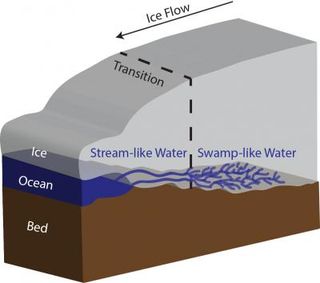
Swamplike Waterways Found Under Antarctic Glacier

A sprawling network of low-lying canals, similar to a swamp, hides under Antarctica's Thwaites Glacier, a new study finds.
The fast-flowing Thwaites Glacier is one of the largest ice streams in West Antarctica. Scientists think Thwaites could significantly retreat in the next 20 years, adding to global sea level rise. Knowing the extent of the waterways underneath Thwaites will help researchers model the glacier's ebb and flow, because the water lubricates the ice.
The new look at the swamplike canals comes from researchers at the University of Texas at Austin, who developed a novel way of analyzing airborne ice-penetrating radar. The findings appeared in the July 8 issue of the journal Proceedings of the National Academy of Sciences.
The swampy drainage system sits under Thwaites Glacier far from where the glacier meets the ocean. There, the land is relatively flat and the waterways appear widespread and well-connected, like a swamp. The canals cover an area several times larger than the Florida Everglades, the researchers said. Closer to shore, the drainage pattern shifts to streamlike channels.
"We now understand both how the water system is organized and where that dynamic is playing itself out," study co-author Don Blankenship of the University of Texas at Austin said in a statement. "Our challenge is to begin to understand the timing and processes that will be involved when that stability is breached."
Email Becky Oskin or follow her @beckyoskin. Follow us @OAPlanet, Facebook & Google+. Original article on LiveScience's OurAmazingPlanet.
Sign up for the Live Science daily newsletter now
Get the world’s most fascinating discoveries delivered straight to your inbox.

